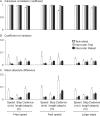Test-Retest and Inter-Rater Reliability of the 20-Meter Ambulation Test in Patients with Parkinson's Disease
- PMID: 36943066
- PMCID: PMC10065119
- DOI: 10.2340/jrm.v55.4381
Test-Retest and Inter-Rater Reliability of the 20-Meter Ambulation Test in Patients with Parkinson's Disease
Abstract
Objective: In patients with Parkinson's disease, limited sit-to-stand, walk and turn contribute to decreased independence and quality of life. The 20-meter Ambulation Test (AT20) evaluates walking a total of 20 m, over a 10-m distance, back and forth between 2 chairs, starting and ending in a seated position. The aim of this study was to evaluate test-retest and inter-rater reliability of the AT20 in patients with Parkinson's disease.
Methods: Patients with idiopathic Parkinson's disease performed the AT20 in 3 conditions: free speed, fast speed, and with large steps, twice 1 week apart. The total number of steps and the time to complete the task were recorded manually by 4 independent raters. The main outcome criteria were the test-retest and inter-rater intraclass correlation coefficients and coefficients of variation for speed, step length and cadence in the 3 conditions.
Results: Twenty participants completed the 2 visits. Across all conditions, test-retest and inter-rater intraclass correlation coefficients for step length and speed were > 95%. Test-retest and inter-rater coefficients of variation were < 0.08.
Conclusion: The AT20 is a reliable ambulation test in Parkinson's disease, with excellent test-retest and inter-rater reliability for step length and speed in all 3 conditions: at free speed, fast speed, and with large steps. The AT20 might be useful to assess ambulation in parkinsonism in clinical practice.
Conflict of interest statement
Figures


References
MeSH terms
LinkOut - more resources
Full Text Sources
Medical

